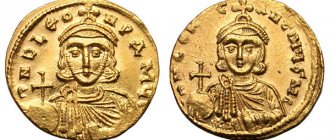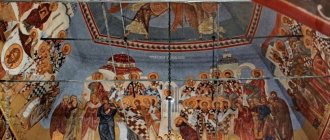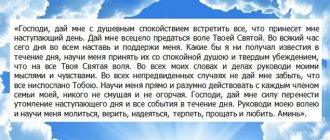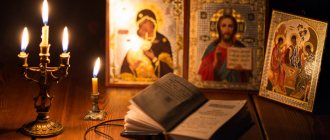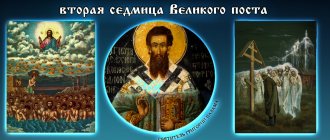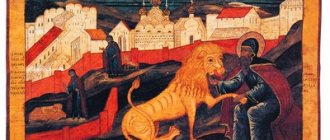| IV Ecumenical (Chalcedonian) Council. |
IV Ecumenical Council of Chalcedon
Commemoration of July 16 and the memory of the holy fathers of the six Ecumenical Councils
- On the map: Yandex.Map, Google map (no exact coordinates)
Took place from October 31, 451 in Chalcedon during the reign of Emperor Marcian. There were seventeen plenary sessions in the church of the highly revered local saint, the Great Martyr Euphemia. The number of participants was especially large - 630 bishops. Bishop Anatoly of Constantinople presided. The Roman bishop Leo the Great was represented by two bishops: Paschasinus and Lucinsius. The Council issued 30 rules.
Review of council meetings
The general direction of the council was largely clarified already at the first meeting, when the personal status of Dioscorus of Alexandria and Theodoret of Cyrus, the main exponent of the views of the “eastern” or Antiochian group, was discussed. The papal legates demanded the expulsion of Dioscorus because he had insulted Pope Leo, while the Egyptians and their allies bitterly protested the presence of Theodoret, who had criticized St. Cyril. Imperial officials refused both. It was decided to seat both Dioscorus and Theodoret in the middle of the temple, like accused persons who, with full right to speak, must defend themselves. This was reasonable not only for reasons of justice, but also in connection with the main goal of the policy of Marcian and Pulcheria: to restore harmony within the imperial Church, centered around the two imperial capitals, Rome and Constantinople. This solution to the procedural issue led to the fact that the meeting was almost completely occupied by a long reading of the protocol of the Council of Constantinople, which condemned Eutyches (448), and the protocol of the “Robber” Council (449). The reading was constantly interrupted by stormy shouts from bishops of different factions. Former members of the “robber” council, who signed the condemnation of Flavian and indirectly offended Leo with their refusal to read his message, tried to justify themselves, either accusing Dioscorus of blackmail and violence, or acting more honestly and asking the council for forgiveness. The most compromised among them was probably Juvenal of Jerusalem, who, together with Dioscorus, was co-chairman of the “Robber” Council. In Chalcedon, he - by no means convincingly - excused himself by ignorance3 and, making an eloquent gesture, stood up from his place next to the friends of Dioscorus and went over to the Antiochians and Constantinoples. Dioscorus took a restrained and dignified position, expressing understandable irony towards the bishops who supported him in 449, but now sided with his accusers. However, he encountered difficulty justifying his position in 449, especially regarding the rehabilitation of Eutyches. He very clearly expressed his own doctrinal position, which remained the position of the majority of opponents of the Council of Chalcedon: Christ is fully God and fully Man, and therefore He has “two natures,” but after their union it is no longer possible to talk about “two natures” existing separately one from the other, since their union into a single being is a perfect union. Dioscorus, of course, did not allow the Greek word phisis (“nature”) to be used to designate anything other than “concrete reality.” Moreover, as both he and his supporters pointed out, Saint Cyril used the expression “the one nature of God the Word incarnate” and never definitely spoke of two natures after their union. Based on this Cyril fundamentalism, Dioscorus believed that the condemnation of Flavian in 449. was fair: Flavian and Eusebius of Dorylaeum, the official accuser of Eutyches in 448, spoke of “two natures after the Incarnation” and therefore de facto were “Nestorians.” However, in Chalcedon, the majority argued that Dioscorus was wrong in seeing a contradiction between Cyril and Flavian.
Imperial officials in their final speech expressed their conviction that the condemnation of Flavian was unjust and therefore those who agreed with him—that is, those who headed the “Robber” Council, Dioscorus, Juvenal (his transition had not yet helped him!), Thalassius Caesarea and others must be deposed. However, officials also said that such an action, which requires a fresh mind and free discussion, should be postponed until the next meeting. The meeting ended with the singing of “Holy God! Holy Mighty! Holy Immortal, have mercy on us." This is the first known instance of this chant being sung, which would become so popular but also controversial in subsequent centuries.
Realizing that his position did not have the slightest chance of triumphing at the council, Dioscorus of Alexandria did not appear at other meetings. His deposition took place in his absence at the third meeting, but only after he had been personally summoned three times. In addition, which is very significant, the decree on his deposition speaks only of disciplinary and canonical sins, and not of heresy. The official message sent to him is as follows: “Know that for the fact that you despised the canons and disobeyed the present Holy and Ecumenical Council, without taking into account other crimes of which you are guilty, since, according to the canons, having been called three times by the real Saint and By the Great Council, did not agree to give an answer to the charges brought against you, you were deposed from the episcopate and deprived of all church rank by this Holy and Ecumenical Council of this October 13th.”4 The purely disciplinary, and not doctrinal, nature of the deposition will be duly noted by Anatoly of Constantinople (who knew Dioscorus well, for he was his representative - apocrisiary - in the capital) at the decisive moment of the debate at the fifth meeting. The real purpose of his speech was to assert that even if Dioscorus accused Flavian of heresy for professing “two natures after their union,” then his own, Cyril’s terminology was not necessarily heretical5. From this it is clear that there was no moment when the Council of Chalcedon retreated from its Cyril position, which it defended at all costs, even going against the tide represented by the Roman legates. Of all the participants in the “robber” council, only Dioscorus was deposed. True, everyone else—including Juvenal of Jerusalem—not only repented, but also signed the deposition of Dioscorus.
Loyalty to Cyril was emphasized with invariable clarity at the third and fifth meetings, when the question of a new doctrinal definition arose. The need for a new definition was expressed by imperial officials at the beginning of the second meeting, and this initially caused almost universal discontent. Indeed, the papal legates received instructions from Pope Leo to insist that the Epistle to Flavian was already a sufficient expression of Orthodoxy and that there was no need for further debate, but only a formal acceptance of the “faith of Peter.” In general, reluctance to issue doctrinal definitions was a general trend. The Eastern bishops themselves—including Dioscorus and his followers—preferred to regard the Nicene Creed as a completely sufficient expression of Orthodoxy. In any case, neither the First Council of Ephesus (431) nor the Second (“Robber”, 449) issued any confessions of faith, but only condemned actual or alleged Nestorians in the name of the Nicene faith6. Moreover, the First Council of Ephesus approved a resolution (later included as Canon 7) prohibiting “the presentation, composition or writing of any statement of faith other than that which was determined by the holy fathers at Nicaea with the Holy Spirit.”7 This decree was constantly referred to by the Alexandrians, who had not yet recognized the Council of Constantinople of 381. and the Creed attributed to him, which was in reality an extension of the Nicene Creed. The Alexandrian Church defined Orthodoxy as strict adherence only to the Council of Nicea, rejecting the Council of 381. and the Creed attributed to him. At the Council of Chalcedon it was attributed to this council for the first time8; this suggested that the Ephesian decree was only a special statement, unrelated to the issue discussed at Chalcedon9.
The officials' demand for a doctrinal definition was completely in agreement with the position of the Empire in relation to the Ecumenical Councils: the emperor convened such meetings for a specific purpose - to receive clear instructions for his policy to ensure the unity of the Church. In 451 a mere reference to the authority of Nicea was clearly insufficient to achieve such clarity, since it was invoked by opposing parties, each of which claimed allegiance to it precisely for its own convictions. A reasonable tactic of the officials was to have all the various documents (supposedly reflecting the "ancient faith") read and thus the bishops themselves would recognize the need to eliminate existing contradictions.
What was to be read were the two Creeds, Nicene and Constantinople, the two “Epistle” of St. Cyril to Nestorius, the conciliatory “Epistle” of Cyril to John of Antioch (433) and the Tomos of Leo to Flavian. The bishops unanimously welcomed both Symbols and Cyril's messages. However, the bishops of Illyricum (theoretically subordinate to the papal vicar in Thessalonica) and Palestine objected to some of the expressions of Pope Leo's Tomos, seeing in them a contradiction with the faith of St. Cyril. This was the main question: it confirmed the need expressed by officials to develop a new definition that would suit both Rome and the Cyril majority of the council.
Pope Leo's "Tomos" was written by a man who knew little about the details of the Christological controversy in the East, but it made an unusually strong impression with its harmonious logical structure, which managed to avoid both the kerygmatic style of Cyril and the errors of Nestorius. There is no information about whether the pope knew Greek, but he studied the problems by reading Tertullian and Augustine, as well as the treatise “On the Incarnation,” the drafting of which was entrusted to St. John Cassian due to Christological disputes. From Latin theology, he rather drew an understanding of salvation that especially emphasized the ideas of mediation and reconciliation, that is, the restoration of the correct and initially harmonious relationship between Creator and creation, than the understanding of deification, theosis, so beloved of the Greek Fathers. It was therefore natural for him to speak of Christ as having two natures, or substances (substantia), although he did not fully understand that the Latin word substantia was usually translated into Greek as hypostasis, which gave his theology a suspiciously Nestorian sound. Based on common sense, he emphasized an important truth, namely, that the two natures of Christ necessarily retain their properties after the union (agit utraque forma quod proprium est), since not in the abstract, but in concrete reality, Christ never ceased to be both God and Man . He added a concept important for the East: the actions inherent in Divinity and humanity respectively are carried out in unity with one another (cum alterius communione). It was this concept of the unity of Divinity and humanity in Christ that was the basis of the doctrine of theosis (deification). And finally, Leo, undoubtedly knowing what is really important for Cyril’s theology and what is especially opposed to the “Nestorian” Antiochian school, affirms theopaschism. “We can say,” he writes, “that the Son of God was crucified and buried, since we understand the unity of personality in both natures.” But since the correct translation into Greek of persona is πρόσωπο (prósopo), his presentation of the personal unity of Christ should only be understood as “prosopic” (as in Antioch), and not as “hypostatic” or “natural” (as in Cyril)10 .
The storm caused by the objections to the text of Pope Leo, the fear of some that the whole of Cyril's theology would be rejected, was so great that the officials were forced to use their power to close the meeting. But first they agreed that Anatoly of Constantinople (an obvious Cyrillicite, a former friend of Dioscorus, a clever church diplomat) would meet with the opposition in order to calm its doubts. Atticus of Nicopolis (in Epirus), one of the objectors, especially insisted that the hitherto unread third “Epistle” of Cyril, containing the Twelve Anathematisms, be read in the plenary session, which should also be taken into account when considering the Orthodoxy of Leo12. In essence, the debate at the third meeting turned out to be a trial of the Orthodoxy of Pope Leo, which was judged on the initial premises gleaned from Cyril.
In the end, it was only at the beginning of the fourth meeting of the council that Leo’s “Tomos” was declared free from any suspicion of heresy. After the statement of Legate Paskhazin (“The Venerable Leo, Archbishop of all churches (!), gave us a statement of the true faith... The council professes this faith... without changing, without deleting or adding a single comment”), the bishops one after another declared that Leo was in agreement with Nicaea, Constantinople, Ephesus and Cyril. The bishops of Illyricum also signed the Tomos, declaring that after meetings with Anatolius they could do so, being quite confident in the Orthodoxy of Archbishop Leo, “since the legates explained to us what seemed contradictory in (Leo’s) expressions.” A similar statement was made by the bishops of Palestine13. Although this meeting was formally in accordance with the instructions that Pope Leo gave to his legates—the Tomos was accepted as a statement of the Orthodox faith—it looked as if Leo was being tried and acquitted on the basis of Cyril's Christology as the criterion of Orthodoxy.
The same meeting was marked by the formal acceptance of Juvenal of Jerusalem and other former friends of Dioscorus into full members of the council. They, of course, also signed Leo’s “Tomos,” and the Council Fathers welcomed the restored unity of the Church. But in reality, the future turned out to be not as rosy as expected: attempts by the cathedral Fathers and officials to achieve doctrinal agreement from the leading group of monks, including the famous Barsauma of Syria, were unsuccessful. These outstanding ascetics, who also took an active part in the “Robber” Council of 449, were presented to the council, but turned out to be less flexible than the bishops. They refused to anathematize not only Dioscorus, but even Eutyches, and thus led the anti-Chalcedonian opposition for the coming decades.
The position of the monks, their claim to be the only legitimate followers of St. Cyril, and their refusal to reject Eutyches all made clear that the preservation of Orthodox Christology, including the legacy of Cyril, requires doctrinal definition. At the fifth meeting of the council there were no longer protests against officials who persistently demanded a doctrinal definition. At this meeting, on October 22, only a select few were present: officials, papal legates, bishops of the main sees (Constantinople, Antioch and Jerusalem) and fifty-two other bishops. The meeting felt more like a steering committee than a plenary session. A draft statement, probably written by Anatoly of Constantinople, was submitted for discussion. Its text was not included in the protocol, but judging by the heated discussions that followed14, it is clear that it contained a clause calling the Virgin Mary Theotokos, that is, a decisive anti-Nestorian statement confirming the decision of the First Council of Ephesus, and also defined the essence of Jesus Christ as a combination of two natures, resorting to strictly Kirillian terminology. The acceptance of such a text would probably have satisfied Dioscorus and helped avoid a schism. Its strongly Cyrillic character provoked a brief objection from John of Germanica, a friend of Nestorius and Theodoret, who apparently was against the inclusion of the term Theotokos. His lonely voice was drowned out by cries: “May Mary be called in writing the Mother of God!” Much more serious was the vigorous and formal protest of the Roman legates: “If the terms are not consistent with the message of the apostolic and most beatified man Leo, the archbishop, give us a copy, and we will return (to Rome), so that the council may meet there.” As we remember, the official position of the Roman Church was that all issues had already been resolved by Leo’s “Tomos” and that essentially no other resolution was needed. Since the officials demanded a resolution, it should at least have been in full accordance with the Tomos. Faced with this difficulty, imperial officials, whose main task was to ensure the unity of both Romes, proposed the creation of a new commission of representatives of all parties to revise the project. The bishops raised a noisy protest against this procedure. Most of them were satisfied with the existing version. The appeal of officials to the emperor and the direct order of Marcian eventually convinced the assembly to form a commission to create a new project.
Historians interpret this episode differently, depending on the premises from which they proceed. Apologists for papal primacy see here a direct victory for the authority of Rome. Eastern Anti-Chalcedonians, past and present, regret what they see as a tragic capitulation to the pope and the emperor. Historians sympathetic to Antiochene and Western Christologies express frustration at the “blindness” of the Greek episcopate, unable to understand the obvious heresy of Dioscorus, and praise the firmness of the legates. However, none of the participants in the cathedral perceived this event in such a simplified form. In fact, all the bishops had signed Leo's "Tomos" at the previous meeting. In their view, this was a completely sufficient expression of their condemnation of Eutyches and their acceptance of the formulation of two natures so energetically advanced by Leo. When the officials asked them a direct question: “Who are you for, Leo or Dioscorus?” they answered without hesitation: “We believe like Leo.”16 They hesitated to write in the decree “in two natures” rather than “of two natures” because they foresaw the dangerous consequences of completely abandoning the terminology used by Cyril. For them, as for the Fathers of the Fifth Council, which would meet a century later, that is, too late to heal the schism, neither the terminology of Cyril (“of two natures”) nor the terminology of Leo (“two natures after their union”) deserved separate and self-sufficient status: both served only to reject false teaching, that is, Nestorianism and Eutychianism, respectively.
Be that as it may, the commission met and came up with the famous Chalcedonian definition, a subtle compromise attempting to satisfy the followers of Cyril (using the terms Theotokos and "union in one person") as well as the Roman legates (claiming that we know Christ "in two natures... while preserving the properties of each of them"), and wisely professing the mystery of the Incarnation, using four negative adverbs (“unmerged, unchangeable, indivisible, inseparable”).
The status of this definition or oros (ὅρος) did not in any way claim to be a new Creed. The use of the term “Chalcedonian Symbol” in modern textbooks17 is erroneous. This text was not intended for liturgical, sacramental or “symbolic” use and was understood only as a definition excluding both the Nestorian and Eutychian heresies. The preamble very clearly defines this negative, “refuting” goal of the creators of the text. The definition includes the full text of the two Creeds—Nicene and Constantinople—followed by the statement that these two Creeds are “sufficient” for the knowledge of truth. And only then, after this conservative and protective statement, does the definition mention Nestorianism, Eutychianism and the “Epistle” of Cyril and Leo (calling each by name), written “to establish the true faith.” This mention of Cyril and Leo once again reflects the council’s conviction that Orthodoxy is expressed by both of them, and not by one or the other separately18. This decree was not intended to replace either the Epistles of Cyril or the Tomos of Leo as the expression of true faith; it had to find a Christological terminology consistent with the faith of both. Therefore, it is completely incorrect to say that Chalcedon renounced Leo (in the statement about the hypostatic union). Here is the paragraph that was so vigorously discussed at the fifth meeting:
“Therefore, following the Holy Fathers, we all unanimously teach that our Lord Jesus Christ is one and the same Son, one and the same perfect in Divinity and perfect in humanity, true God and true Man, one and the same, consisting of verbal (rational) soul and body, consubstantial with the Father in Divinity and the same consubstantial with us in humanity, similar to us in everything except sin; born of the Father before the ages according to Divinity, but He was born in the last days for our sake and our salvation from Mary the Virgin and Mother of God according to humanity; one and the same Christ, Son, Lord, Only Begotten, cognizable in two natures (εν δύο φύσεσιν) unmerged, unchangeable, indivisible, inseparable; the difference of His natures never disappears from their union, but the properties of each of the two natures are united in one person and one hypostasis (εις εν πρόσωπον και μίαν υπόστασιν συντρεχούση) so that He is not divided and is not divided into two persons, but He is one and the same the Only Begotten Son, God the Word, Lord Jesus Christ; exactly as the prophets of ancient times spoke about Him and as Jesus Christ Himself taught us, and as He conveyed to us the Symbol of the Fathers.”
This definition was signed by 454 bishops at the sixth meeting, on October 25, in the presence of the Emperor Marcian himself, who addressed the assembly first in Latin and then in Greek and was hailed as the “new Constantine” and his wife Pulcheria as the “new Helen”.
For further history, what happened at the ninth and tenth sessions (October 26-27) was important: the rehabilitation of two outstanding bishops condemned by the “Robber” Council, Theodoret of Cyrus and Willow of Edessa. Theodoret was criticized by the First Council of Ephesus and Cyril in his writings; Iva wrote a letter to the Persian Maris, accusing Cyril of Apollinarism. Both vindications were pronounced only after both Theodoret and Iva had formally anathematized Nestorius. At first, Theodoret’s hesitation caused the indignation of the bishops, but he was recognized as Orthodox as soon as he finally said: “Anathema to Nestorius!” Theodoret was in fact a learned and moderate man, the organizer of reconciliation between Cyril and John of Antioch in 433. He clearly hoped that unity could be restored without anathematizing former friends. But the rehabilitation of him and Iva, which meant the acceptance into communion by the council of two former prominent and outspoken critics of Cyril, would be used by the “fundamentalist” followers of Cyril (who would become known as Monophysites) in their denigration of the entire Council of Chalcedon.
Rule 1, Rules of the Holy Apostles – In the Light of the Bible
The word “bishop” (ἐπίσκοπος), firstly, refers in the Divine and Holy Scriptures in the proper sense to God, who takes care of everything and supervises (ἐπισκοποῦντα) over everything, as Job testifies: This is the inheritance of the wicked man from the Lord, and his acquired property from Overseer (παρὰ τοῦ ἐπισκόπου) (i.e. from God) (Job 20:29). And again: Your care (ἐπισκοπή) has guarded my spirit (Job 10:12). This word also applies to our Lord Jesus Christ, as the supreme apostle. Peter says about Him: For you were like sheep that went astray, but have now returned to the Shepherd and Overseer (Ἐπίσκοπον) of your souls (1 Pet. 2:25).
Secondly, this title by grace also applies to those chosen by God, as God Himself speaks of Eleazar: Overseer (ἐπίσκοπος) Eleazar, son of Aaron the priest (Num. 4:16). And God says to Ezekiel: Son of man! I have made you a watchman (σκοπόν) for the house of Israel (Ezek. 3:17). Generally speaking, in the Old Testament bishops are called, on the one hand, guardians and guardians of the internal church government and affairs (as it is written about the aforementioned Eleazar that he kept watch (ἐπισκοπήν) over the entire tabernacle (see Numbers 4:16), and about high priest Jehoiada, that he appointed bishops for the house of the Lord: And the priest appointed overseers (ἐπισκόπους) in the house of the Lord (2 Kings 1:18)), and on the other hand, overseers of the external public affairs and administration, as it is written, Moses was angry with the overseers ( ἐπί τοῖς ἐπισκόποις) troops, captains of thousands and captains of hundreds (Numbers 31:14).
However, none of the apostles was elected or named bishop during the Lord’s life on earth, since He is the only Guardian (ἐπίσκοπος) of our souls: the apostles only had the power to heal every disease and cast out demons (Matthew 10; Mark 3). After the resurrection from the dead and the ascension of our Savior, sent by Him (as He Himself was sent by the Father) throughout the world and receiving all the power to knit and tie and all the gifts of the All-Holy Spirit on the day of Pentecost, they had not only the apostolic title (in essence) , but also episcopal, as Saint Epiphanius testifies in the chapter on the 27th heresy, “the apostles Peter and Paul themselves were the first bishops,” and likewise all the other apostles, as the fathers claim. Therefore, they decreed that bishops should be ordained by three or two bishops in cities. But the apostles themselves, as Saint Clement says in the First Epistle to the Corinthians, “preaching throughout countries and cities, appointed the firstborn of them, after being tested by the Spirit, to be bishops and deacons for those who would believe.” Therefore, the God-bearing Ignatius, in his letter to the faithful in Trallae, commands: “Revere your bishop as Christ, according to the commandment given to you by the blessed apostles.” And that’s all for the word “bishop.”
The word “ordination” (χειροτονία) comes from the expression “to stretch out, or stretch out, hands” (τείνω τὰς χεῖρας) and has two meanings. For consecration is the name of both voting and simply election to some office, which took place by a show of hands by the people, as Demosthenes says, “whoever by a show of hands you choose (χειροτονήσητε) as a military leader” (Homily 1 against Philip). And in particular, this word corresponds to the church custom that prevailed in ancient times, when the assembled people freely “consecrated” (ἐχειροτόνουν), that is, elected bishops by stretching out their hands, as Zonara says about this, although this was subsequently the order of the Council of Laodicea in the 5th canceled his rule, declaring: “Consecrations (that is, elections - St. N.) should not be performed in the presence of listeners.”
At the present time, ordination is the name given to a sacred act performed by a bishop, in which, simultaneously with prayer and invocation of the Holy Spirit, he places his hand on the head of the person being ordained, as is mentioned by the apostle: Do not lay your hands on anyone hastily. In fact, this order is well known to everyone.
So, this rule stipulates that every bishop (be it a metropolitan, archbishop or bishop) must be ordained by two or three bishops. But it is obvious that the image of expression here is inverse. Indeed, without this figure of speech, to put it more simply, this rule would sound like this: “Let three or (at least) two bishops ordain bishops.” This is exactly how, without inversion, the same rule was stated in the Apostolic Constitutions, which read: “We command that a bishop should be ordained by three bishops or, at the very least, two.”
Coordination
In accordance with this rule, various other rules are also laid down. Namely, it must be that either all the bishops of the metropolitan region (according to I Ose. 4, VII Ose. 3, Antioch. 19), or many (according to Carthage 13) gather together and ordain a bishop. Since this is difficult, it is appropriate for at least three to ordain, and the rest to express their consent to his ordination through letters. Confirming this apostolic canon, the 58th canon of the Council of Carthage states: “Let the ancient order be observed: for the consecration of bishops, no less than three bishops are needed,” namely one metropolitan and two other bishops. The 1st rule of the Local Council of Constantinople states the same thing. And the 12th canon of the Council of Laodicea determines that bishops should be appointed to church administration according to the judgment of the surrounding bishops. If it happens that in any metropolitan region there remains one bishop who, having been called by his metropolitan, neither goes himself nor through a letter adds his vote in favor of the one who is to be ordained as a bishop, then the metropolitan must both elect and to ordain him with the help of the bishops of the neighboring, foreign metropolitan region. In the same way, this metropolitan himself must be elected and ordained by neighboring bishops, according to Sardik. 6. “Apostolic decrees” (book 8, chapter 27) prescribe that a bishop who is ordained by one bishop should be deposed together with the one who ordained him, except in the case when, due to difficult circumstances caused by persecution, or for some reason For some other reason, many bishops could not meet together and, by their choice, he was ordained alone. Thus, Siderius was ordained bishop of Palebiscin (according to the testimony of Synesius) not by three bishops, but by one bishop. Philo - because of the cramped position of the bishops at that time.
